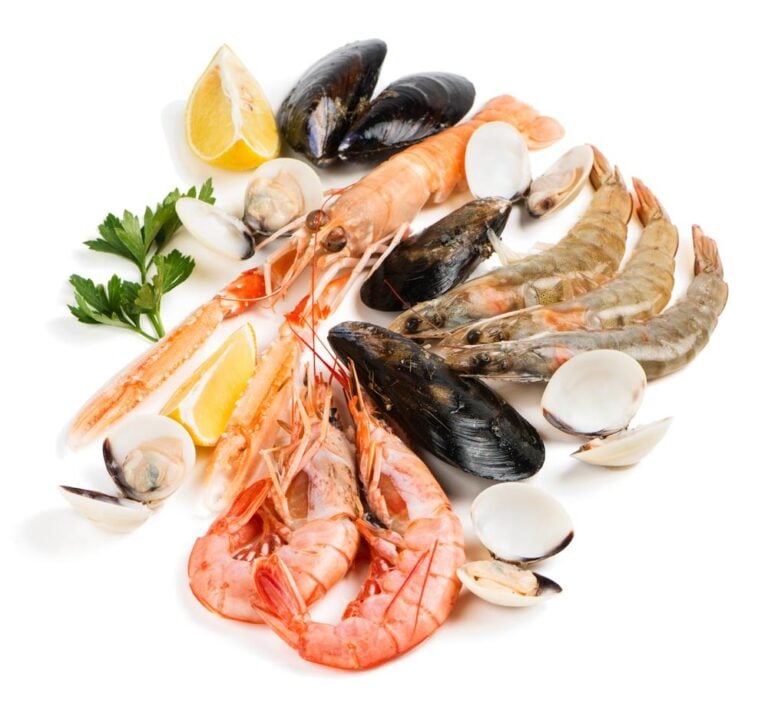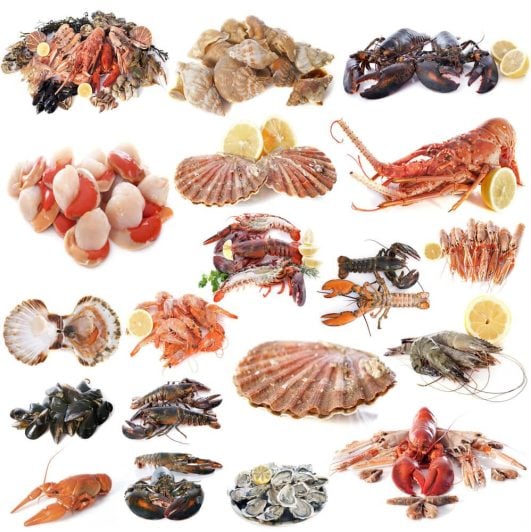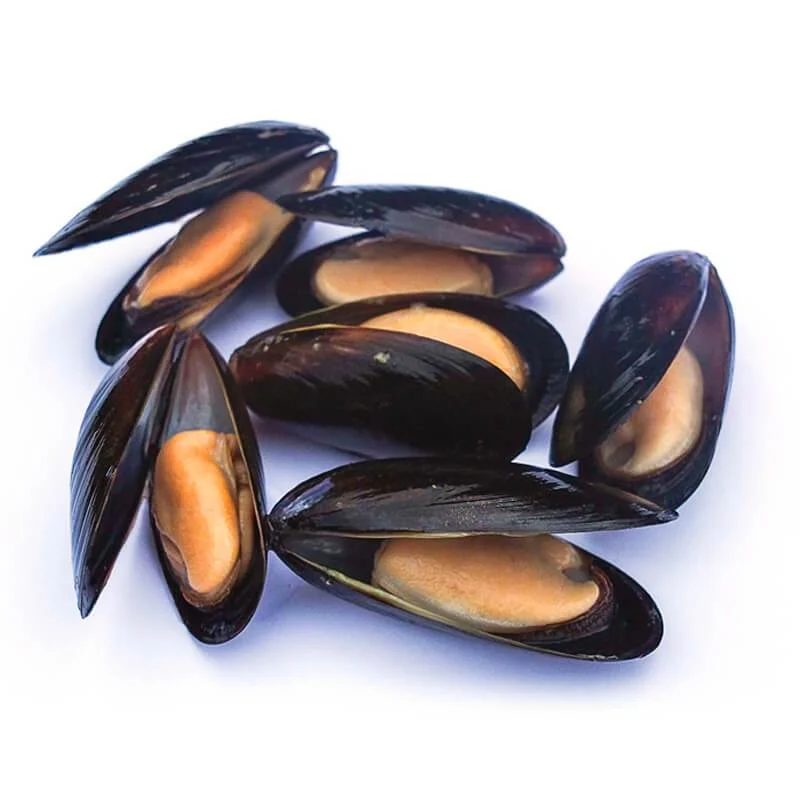What is a Mollusc Allergy?
The majority of major food allergies are triggered during childhood, but molluscs stand out as an exception. An allergy to shellfish can develop at any point during a person’s life, but is more common in adults. It can be caused by foods that you’ve eaten before with no issues.
While the prevalence of mollusc allergies is unknown it’s common enough to qualify as one of the 14 Main Allergens, and as a result businesses in the UK are required to declare if this ingredient is any sold products.
The cause of mollusc allergies are most often the immune system’s response to a protein found in shellfish muscles called tropomyosin. Unfortunately, allergies to shellfish are usually lifelong and not outgrown, and as this protein is found in many shellfish it’s possible to be allergic to more than one type of seafood.
Mollusc Allergy Symptoms
It can take some time for symptoms to be present after eating molluscs, but most develop within minutes. The symptoms of a mollusc allergy may include:
- Itchy rashes, or hives
- Dizziness, which may resulting in fainting
- Swelling of the mouth, tongue, face, or other region
- Wheezing and difficulty breathing
- Diarrhoea and/or vomiting
- Abdominal pain
Anaphylaxis, a severe allergic reaction that can be life-threatening, can occur in extreme cases. Symptoms of anaphylaxis include:
- A swelling of the throat, making it especially difficult to breath or talk
- Shock, following a severe drop in blood pressure
- A rapid pulse
- Severe breakouts of rashes, hives, or swelling
- Severe diarrhoea and/or vomiting
- Dizziness, possibly resulting in loss of consciousness
While rare, it’s also possible to experience an allergic reaction by being exposed to proteins in cooking vapour by boiling molluscs for example.
Different Types of Molluscs
To avoid foods containing molluscs, it’s important to understand the main characteristics of this group. Molluscs are diverse, with over 85,000 different species. For easier categorisation they are split into ten classes, with three of these containing the majority of the species.
The three main groups are:
Gastropods – typically have a large foot used for movement with their body covered in a single coiled shell. This group is mainly made up of snails and slugs on land and in water.
Bivalves – Bivalve molluscs are typically soft-bodied creatures that live within a shell made up of two parts that opens and closes. Examples are clams, oysters, and scallops.
Cephalopods – Cephalopods are identified by a head and foot that are connected together, followed by sets of arms or tentacles. They also always have bilateral symmetry, just like humans. Examples of cephalopods are octopus, squid, and cuttlefish.
What is a Crustacean Allergy?
Crustaceans are aquatic invertebrates, meaning they have no backbone with a segmented body and jointed legs. In the UK and EU, according to food law, crustaceans and molluscs are considered to be two different food allergens that food businesses must declare on packaged foods and on restaurant menus.
This differs in the USA, however. Unlike in the UK and EU, molluscs (e.g., land snails and whelks) are not considered a major food allergen in the USA, and do not fall under the definition of ‘crustacean shellfish’ (e.g., lobster, langoustines, and prawns). As a result, molluscs are also not subject to the same labelling regulations as crustaceans.
Crustacean allergy is an abnormal reaction by the body’s immune system to proteins found in some marine animals. Marine animals in the shellfish category include crustaceans and molluscs, such as shrimp, crab, lobster, squid, oysters, scallops, and others. Some individuals with crustacean allergies react to all shellfish; others only to certain kinds. Reactions range from mild symptoms, such as hives or a stuffy nose, to more severe and life-threatening symptoms.
Seafood use and production, especially shellfish, have steadily increased in recent years. As a result of the higher consumption rate, adverse health problems have increased among consumers, including allergic reactions.
Crustacean allergies affect adults and are less common among young children, especially in regions with a high rate of consumption. These allergies tend to develop later in life than the common childhood allergies. According to the NHS, most children who have an allergy to crustaceans usually do not have an allergy to white fish, salmon, or tuna, though it is best to consult with an immunologist before changing your diet.
After consuming crustaceans, allergic symptoms appear similar to those experienced following consumption of other allergens like peanuts or gluten.
An allergic reaction may occur immediately, though it’s possible a reaction may not occur for a few days after ingesting the allergen. An allergic reaction to seafood can be mild or life-threatening. Some mild to moderate symptoms include:
- Itchy rashes, or hives
- Dizziness, which may resulting in fainting
- Swelling of the mouth, tongue, face, or other region
- Wheezing and difficulty breathing
- Diarrhoea and/or vomiting
- Abdominal pain
Anaphylaxis, a severe allergic reaction that can be life-threatening, can occur in extreme cases. Symptoms of anaphylaxis include:
- A swelling of the throat, making it especially difficult to breath or talk
- Shock, following a severe drop in blood pressure
- A rapid pulse
- Severe breakouts of rashes, hives, or swelling
- Severe diarrhoea and/or vomiting
- Dizziness, possibly resulting in loss of consciousness

Crickets and the Crustacean Allergy
As crickets have similar proteins to crustaceans, many people with crustacean allergies will also be allergic to the consumption of crickets. People with crustacean allergies can experience allergic reactions without eating these foods on rare occasions. Exposure to the proteins in cooking vapours (such as steam from boiling lobsters) and dishes can also cause an allergic reaction.
The inhalation of crustacean shellfish aerosols during food preparation and processing can result in rhinitis (runny or blocked nose, and sneezing), and itchy eyes.
Since shellfish retain their allergenic potential even after cooking, avoidance of all forms of shellfish is essential. Crustaceans may be present in some processed instant foods (some include: sauces, pizza, salad dressings, and garnishes).
Crustacean Examples
Other than the simple forms of crustaceans such as lobster, langoustines, crab, and prawns; crustaceans may be present in several other food items. We advise that you always check the label of pre-packed foods and inform your servers of your allergies in restaurants.

Those allergic to crustaceans may need to avoid eating:
- Prawn crackers
- Chips
- Marron
- Combination foods, such as fried rice, paella, and spring rolls
- Yabbies
- Crayfish
- Dips and spreads, such as crap dip and many fish pâtés
- Prawns
- Balmain bugs
- Scampi
- Krill
- Garnishes, e.g. caponata and antipasto
- Barnacle
- Thenus
- Sauces, e.g. marinara and oyster sauce
- Chitin
- Shrimp
- Fried foods (from frying oil)
- Salad dressings
- Lancashire hotpot (these traditionally contained oysters)
- Fish sauce – is commonly served here in the UK and also elsewhere in the world. It can be made with shellfish as well as fish, though vegetarian and vegan options are available.
- Oyster sauce (in Chinese meals, this is used to flavour some savoury dishes)
Dishes that you may need to avoid if you have a Crustacean allergy:
- Sushi
- Jambalaya
- Asian soups and dishes
- Seafood extender
- Gumbo
- Bouillabaisse
- Paella
- Fried rice
Always read the label and check with your server in restaurants.
Different ways to list crustaceans on food packaging:
- Crayfish (crawfish, écrevisse)
- Lobster (langouste, langoustine, coral, and tomalley)
- Prawns
- Shrimp (crevette)
It is possible that some people allergic to one type of seafood are not allergic to others. Many people are only allergic to a single type of seafood. Sometimes seafood is referred to collectively as fish (e.g., trout, salmon), crustaceans (e.g., lobster, shrimp), and molluscs (e.g., scallops, clams). People may be able to consume fish safely, but be allergic to crustaceans like lobsters and crabs.
LiberEat Allergen Detection Technology
Food allergen rules and regulations continue to change and evolve. Food businesses must be vigilant when working with ingredients that contain allergens, and exercise due caution when providing ingredient and allergen information to consumers.
LiberEat Allergen Detection Technology provides an allergen safety blanket for food businesses to ensure that consumers are safe and healthy when eating at your restaurant brand or consuming your food products.
LiberEat offers a second line of defence for food businesses by detecting errors, allergens, and other harmful ingredients. Food businesses can apply this technology directly to identify errors in allergen communications, preventing the risk of injury. Get in touch with us today to learn more about our allergen detection technology.
To find out how LiberEat Technology supports food businesses to detect allergens and errors, to protect consumers
Sources
Allergens and molecular diagnostics of shellfish allergy | National Library of Medicine
Shellfish allergy | Mayo Clinic
Shellfish Allergy | North West Allergy Network
Gambierdiscus toxicus | ScienceDirect
About the EU Food Information for Consumers Regulation | Food Standards Agency
Information for people with a crustacean allergy | Government of Canada
Food Allergen Labeling and HACCP Control for the Seafood Industry | Virginia State University

